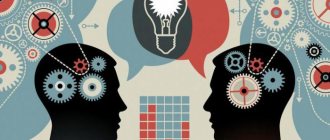Features of social perception
The psychological mechanisms of people's perception of each other are represented by the mechanisms of social perception. They involve the emergence in a person of an image of social objects and phenomena, including other people, groups, societies and phenomena.
The process of social perception characterizes the complexity of the perception of social objects, as well as their significant difference from the perception of material objects. Social perception is characterized by the following qualities:
Are you an expert in this subject area? We invite you to become the author of the Directory Working Conditions
- Great subjectivity
- bias,
- Individuality,
- The role of psychological characteristics of perceiving people or groups.
The objectivity of people's perception of each other depends on judgments about a person or group. If we take into account external impressions, then it is minimal, since the most significant and characterizing thoughts, beliefs, goals, motives, habits, qualities, abilities, traditions, etc. are hidden behind the appearance and cannot be clearly represented in it.
The psychological mechanisms of people’s perception of each other are also associated with a mental transition from the externally observable to the internal. They refer to the consideration of the latter as the essence, main characteristic or cause of what is observed. It is obvious that this process, as well as its results, directly depend on the ability of those who perceive to mentally “see” and understand the inner behind the external. This requires personal knowledge, beliefs, attitudes, attitudes, experience, etc.
The general mechanisms of the mental process of perceiving objects of reality have their own specificity in the case of a person’s perception of various social phenomena. Identification of signs of another person that are significant for a person and correlation with a selected category of people, social groups and communities is called social categorization.
Finished works on a similar topic
Course work Psychological mechanisms of people's perception of each other 410 ₽ Abstract Psychological mechanisms of people's perception of each other 230 ₽ Test work Psychological mechanisms of people's perception of each other 210 ₽
Receive completed work or specialist advice on your educational project Find out the cost
Data from psychological research have shown that the same individual can be included in different social categories. Sometimes they can be of polar evaluative coloring in accordance with the action of other factors of his perception.
Mechanisms of people’s perception and understanding of each other
1) Identification
is a socio-psychological process of cognition by an individual or a group of other people in the course of direct or indirect contacts with them, in which the internal states or position of partners, as well as role models, are compared or contrasted with their psychological and other characteristics.
Identification, as opposed to narcissism, plays a huge role in human behavior and spiritual life. Its psychological meaning lies in expanding the range of experiences, in enriching internal experience. It is known as the earliest onset of emotional attachment to another person. On the other hand, identification often acts as an element of people’s psychological protection from objects and situations that cause fear, generating anxious and tense states.
2) Empathy
is emotional empathy for another person. Through emotional response, people perceive the inner state of others. Empathy is based on the ability to correctly imagine what is happening inside another person, what he is experiencing, and how he evaluates the world around him. It is almost always interpreted not only as an active assessment by the subject of the experiences and feelings of the cognizing person, but also certainly as a positive attitude towards the partner.
3) Attraction
is a form of knowing another person, based on the formation of a stable positive feeling towards him. In this case, understanding the interaction partner arises due to the emergence of attachment to him, a friendly or deeper intimate-personal relationship. All other things being equal, people more easily accept the position of the person towards whom they have an emotionally positive attitude.
4) Reflection
is a mechanism of self-knowledge in the process of interaction, which is based on a person’s ability to imagine how he is perceived by his communication partner. This is not just knowledge or understanding of a partner, but knowledge of how a partner understands me, a kind of double process of mirror relationships with each other.
5) Causal attribution
– a mechanism for interpreting the actions and feelings of another person (causal attribution – the desire to find out the reasons for the subject’s behavior).
Research shows that each person has his own “favorite” causal schemes, i.e. usual explanations of other people's behavior: a) people with personal attribution in any situation tend to find the culprit of what happened, to attribute the cause of what happened to a specific person; b) in the case of an addiction to circumstantial attribution, people tend to blame circumstances first of all, without bothering to look for a specific culprit; c) with stimulus attribution, a person sees the cause of what happened in the object to which the action was directed (the vase fell because it didn’t stand well) or in the victim himself (it was his own fault that he got hit by a car).
When studying the process of causal attribution, various patterns were identified. For example, people most often attribute the reason for success to themselves, and failure - to circumstances. The nature of the attribution also depends on the extent of the person’s participation in the event under discussion. The assessment will be different in cases where he was a participant (accomplice) or an observer. The general pattern is that as the significance of the incident increases, subjects tend to move from circumstantial and stimulus attribution to personal attribution (i.e., look for the cause of the incident in the conscious actions of the individual).
6) Decentration
– this is the opposite of egocentrism; possible change of position and coordination of one’s point of view with other possible points of view; this is the ability to refuse to take one’s Self as a point of reference and the ability to switch to another point of view. Inadequate decentration – when it is used for manipulation. Levels of decentration: a) change of perceptual position and coordination of one’s point of view with the point of view of another. b) accepting the point of view of another.
Abstract topics:
1. Comparative analysis of socio-psychological theories and concepts of human communication.
2. Communication barriers and ways to overcome them.
3. Communicative competence and opportunities for its development.
4. The emotional side of interpersonal perception is the phenomenon of attraction.
5. Business communication.
Recommended reading:
1. Andreeva G.M. Social Psychology. – M.: Aspect Press, 2004.
2. Aronson E., Wilson T., Eikert R. Social psychology. Psychological laws of human behavior in society. – SPb.: Prime-EVROZNAK, 2004.
3. Psychology of communication / E.I. Rogov. – M.: Humanitarian. Ed. VLADOS Center, 2005.
4. Sushchenko S.A. Social Psychology. – Rostov-on-Don: “Phoenix”, 2005.
5. Taylor S., Piplo L., Sears D. Social psychology. – St. Petersburg: Peter, 2004.
Perception disorders
1) Illusions are erroneous perceptions of real objects and phenomena. They can be auditory, visual, olfactory, etc.
Under certain conditions, they occur in most people and can be caused by physical (perception of a spoon in a glass of tea that appears broken), physiological (split images of objects if you press on the side of the eyeball at the moment of perception) and psychological reasons (overestimation of vertical lines compared to horizontal ones) .
Illusions of perception
a) Ebbinghaus illusion
This is an optical illusion of perception regarding size. Two objects of the same size can look different. If one object is placed among smaller objects, it will appear larger than if the same object is placed among larger objects.
b) Ponzo illusion
This is an optical illusion of perception. Mario Ponzo suggested that the human brain determines the size of an object by its background. He drew two identical segments against the background of two converging lines, like a railway track stretching into the distance. As a result, horizontal lines are perceived differently.
c) Aristotle's illusion
This is an illusion of touch. A small object (pencil) is placed between (under) crossed fingers (it’s easier to use the middle and index fingers) so that it touches one finger on the inside and the other finger on the outside. When you move your fingers (and hand) over an object (back and forth), after a while you get the impression that your fingers are touching 2 objects.
d) Zellner illusion
An optical illusion in which parallel lines intersected by a series of short diagonal lines appear to diverge.
e) Müller-Lyer illusion
An optical illusion that occurs when observing segments framed by arrows. The segment framed by the “points” seems shorter than the segment framed by the “tail” arrows.
f) Poggendorff illusion
An optical illusion where the red line is a continuation of the black line, rather than the blue one.
Hallucinations
2) Hallucinations are erroneous perceptions in the absence of an object.
Hallucinations occur with alcohol abuse (delirium delirium), drugs, psychostimulants (LSD, cocaine, etc.), medications (for example, antidepressants), mental illness (schizophrenia, epilepsy), organic brain lesions, cataracts (Charles hallucinations). Bonnet).
Mechanisms of person’s perception by person and mutual understanding in the process of communication
The idea of another person is closely related to the level of one’s own self-awareness. Analysis of self-awareness through another person is carried out using two concepts: identification and reflection.
25 pages, 12060 words
016_Man. Its structure. Subtle World
... the contact became conscious. It is with consciousness that a person must touch and touch the Higher Worlds, because unconscious communication with them will not give the necessary consequences... Sleep is a small death How to refine... profitably and extract very interesting and instructive impressions. The main existence (of man) is at night. An ordinary person can live no more than a few days without sleep under normal conditions. ...
Lecture No. 1. Psychology of communication
Man is unthinkable without people.
Goethe
Target:
Study the topic “Communication”. Expand the meaning of the concept of “communication”; consider types and levels of communication. Introduce students to various means of communication, reveal the techniques of non-verbal communication. Pay special attention to the mechanisms of interpersonal perception and understanding of people in the process of communication. Give an idea of the main phenomena of interpersonal communication; analyze the reasons leading to distortion of information in the process of people’s perception of each other. Develop skills in interpreting nonverbal means in communication. Develop the ability to better perceive and understand other people in the process of communication.
Plan:
1. The concept of communication.
2. Types and levels of communication.
3. Means of communication.
4. Mechanisms and effects of interpersonal perception.









